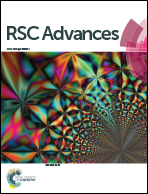Preparation, characterization and application of Cu–Ni/TiO2 in Orange II photodegradation under visible light: effect of different reaction parameters and optimization†
Abstract
Bimetallic Cu–Ni/TiO2 photocatalysts were prepared using a wet impregnation method. The physicochemical and morphological properties of the photocatalysts were studied using different characterization techniques. FTIR analysis showed the nitrate peaks are still present but did not show an effect on the catalytic performance of the photocatalysts. Photocatalysts were of nanosize and their morphologies are spherical and slightly agglomerated. From DR-UV-visible analysis, it was proved that incorporation of Cu and Ni onto TiO2 has successfully shifted the optical absorption to the visible region with reduced bandgap energies. Furthermore, by increasing the calcination temperature the bandgap energy was reduced. The lowest band gap energy (2.74 eV) was reported for 9Cu : 1Ni-300. Photocatalytic degradation of Orange II was studied under visible light. The photocatalyst performance of bimetallic Cu–Ni/TiO2 for Orange II decoloration and mineralization is promising compared to bare TiO2 and the monometallic photocatalysts. Compared to other Cu : Ni mass compositions, results for photodegradation studies showed that a 9Cu : 1Ni mass composition was observed with 100% Orange II decoloration and 89.8% and 100% TOC removal in 1 h and 1.5 h of irradiation duration, respectively. The optimum pH value was 6.8. The main identified intermediates and by-products of Orange II photodegradation under visible light irradiation during reaction as a function of time were oxalic acid, formic acid, formaldehyde, benzyl alcohol and benzaldehyde as measured by HPLC analysis.


 Please wait while we load your content...
Please wait while we load your content...